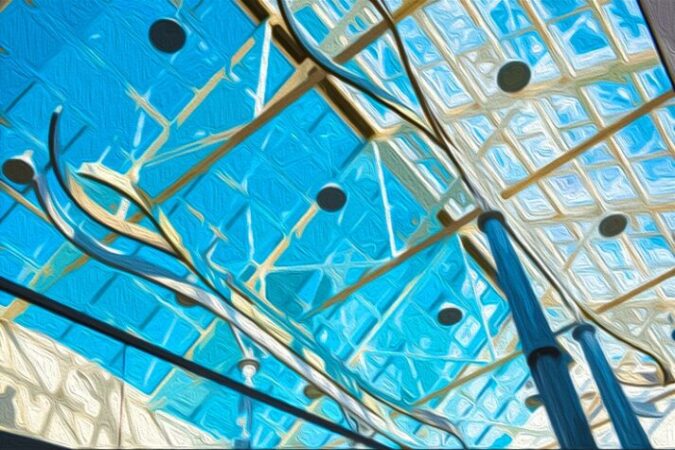The Boring Company unveiled the first tunnel for a proposed underground transportation system in Los Angeles County at an event held in Hawthorne (California), U.S.A. December 18, 2018. The Boring Company unveils the first tunnel of a proposed underground transportation network in Los Angeles County during an event in Hawthorne, California, U.S. December 18, 2018.
Facebook spent $20 million to plan to revitalize a railway bridge near its offices to improve traffic.
Facebook’s failure to save an old railway bridge near its offices is one of the latest problems facing tech companies trying to solve transportation woes.
After acquiring Instagram and Whatsapp, the social media company wanted to renovate Dumbarton Rail Bridge — an abandoned railway that crosses San Francisco Bay — to make it more modern. It had nearly ten times the employee headcount in six years. From 3,200 workers in 2011, to over 25,000 by 2017, which was a significant increase.
The bridge was built to improve traffic flow to Facebook’s headquarters, expand Facebook’s property portfolio and renovate the railroad that had been dormant for over 40 years.
The failed $20 million project, which was initiated in 2017 but abandoned in 2020 because of political hurdles and COVID-19 problems, may offer a glimpse into Elon Musk’s future. According to The New York Times, a deep dive on the project published Saturday by The New York Times — it may also be a glimpse at Elon Musk’s Boring Company. The Wall Street Journal has described the Boring Company as “ghosting” major US towns by denying proposals to build tunnel systems.
The Boring Company is an infrastructure company that started as a subsidiary to SpaceX, but was separated in 2018. It has pledged since its inception to construct high-speed tunnels throughout major cities to improve pedestrian and traffic access. The company was valued at nearly $5.7 billion after it raised $657 million through series C funding.
The Boring Company only completed one project since the completion of its Hawthorne research and development tunnel in California in 2018. It was a 1.7-mile loop linking the Las Vegas Convention Center and its Exhibit Hall campuses.
The Boring Company has scrapped plans for other tunnels, including one connecting Los Angeles to Baltimore and the Chicago airport to its downtown area.
TechCrunch reported that Los Angeles plans to construct tunnels under the 405 freeway, near Dodger Stadium, were scrapped in 2018 and 2021 after being criticised by city council members as “rushed.”
The DC-Baltimore transit system was announced in 2017 but was cancelled in 2021 due to delays in permitting and environmental review.
The Boring Company’s 2018 bid to construct high-speed tunnels from Chicago to O’Hare Airport was rejected by Chicago Business Journal. This was in response to public criticism of the technology’s lack of testing.
“Everytime I see him on TV, with a new project or whatever, I’m like, Oh, I recall that bullet train to Chicago O’Hare,” The Wall Street Journal reported Scott Waguespack, Chicago city council member, in reference to Musk.
Ex-high ranking executives at The Boring Company claim that the company has difficulty retaining engineers and technical staff. This is due to Musk’s strict leadership style which requires employees to work 120 hours a week and sleep on couches in factories.
Musk sent a series of humorous tweets in 2016 that seemed to be jokingly referring to traffic, and promised to dig tunnels.
“Traffic is driving my nuts. He posted: “I’m going to build a tunnel boring device and just start digging …,”” at 5:05 a.m. Later, he said: “I actually plan to do this.”
December 17, 2016, Elon Musk (@elonmusk).
Although journalists and consumers were quick to question Musk’s intentions for The Boring Company creation, the early progress in its development has silenced critics for many years.
On its website, modifications to the Las Vegas Loop are the only tunnel projects currently listed. It is not clear if The Boring Company will submit further bids for tunnel projects or complete the planned additions to the Vegas Loop.
Online, critics voice concerns that the entire company was a “scam”, or “bait-and-switch” that was “designed “to propose automobile alternatives for mass transit projects” in order to drive business to Tesla’s electric vehicle company.
Facebook continues to invest massively in infrastructure, including submarine cable acquisitions and development, despite its failure to realize the Dumbarton Rail Bridge Project.
According to Fair Internet Report, an independent market research firm, Meta, the social media company, was rebranded as Meta after it started the cable development project and abandoned the bridge plan. It has acquired 6% worldwide operating cable routes as of 2022. Meta will own more than 13% interest in the submarine cable infrastructure worldwide by the completion of its 2Africa project. This includes 33 countries and 36% of the population.
Although The Boring Company’s future is uncertain, Musk appears to be continuing to innovate existing infrastructure through his numerous businesses. This includes plans to use Tesla’s energy storage technology to “shift all of the energy infrastructure and transport infrastructure of the earth”, Electrek reported.
Insider reached out to representatives of Facebook and The Boring Company for comment but they did not respond immediately.
Business Insider has the original article.
—————————————————————————————————————————————
By: ktangalakislippert@insider.com (Katherine Tangalakis-Lippert)
Title: Infrastructure innovation derailed: How Facebook’s failed plan to turn a century-old railway into a commuter bridge may serve as a warning for The Boring Company
Sourced From: www.businessinsider.com/facebooks-failed-bridge-glimpse-at-future-of-the-boring-company-2023-1
Published Date: Mon, 09 Jan 2023 02:06:28 +0000





Leave a Reply